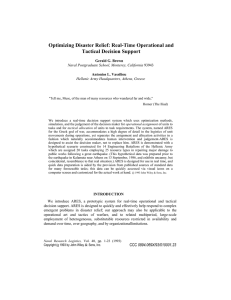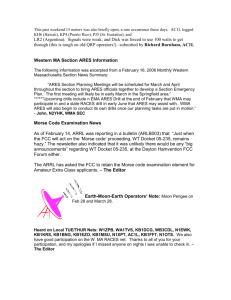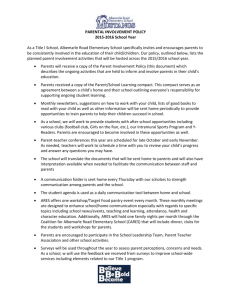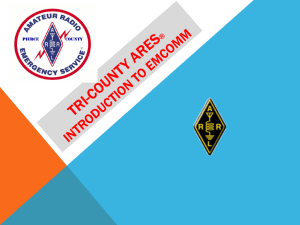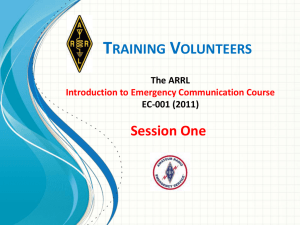Emergency Communications Plan - Hill Country Amateur Radio Club
advertisement
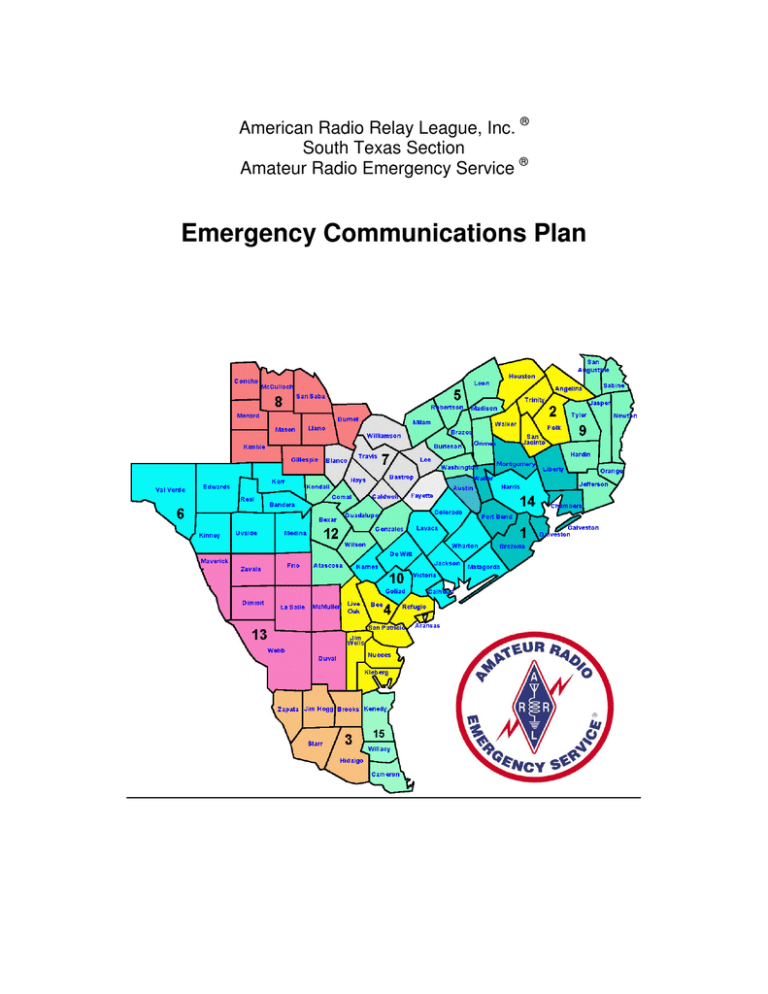
American Radio Relay League, Inc. ® South Texas Section Amateur Radio Emergency Service ® Emergency Communications Plan ® American Radio Relay League, Inc. South Texas Section ® Amateur Radio Emergency Service Emergency Communications Plan South Texas Section Amateur Radio Emergency Service Emergency Communications Plan APPROVAL This document is hereby accepted for implementation and supersedes all previous editions. ____Lee Cooper_____ August 20, 2011 DATE LEE COOPER, W5LHC SECTION M ANAGER SOUTH TEXAS SECTION ARRL Revised August 3, 2011 version 3.0 2 ® American Radio Relay League, Inc. South Texas Section ® Amateur Radio Emergency Service Emergency Communications Plan RECORD OF CHANGES Action Substantial revision in content and structure. Clarification edits sections 1-5 based on DEC inputs Changes to sections 6.4.1 and 6.4.2 for situational reports CCG added to definitions, 6.4.1, 6.4.2 and Appendix C Various corrections to Appendix A CCG email accounts and contact list location updated in Appendix C Typo on District size corrected page 17 Changes to reflect dissolution of District 11 Resource Types updated in Appendix A to align with Texas RASP Revised August 3, 2011 version 3.0 3 Change Date 1/31/2010 2/8/2010 7/15/2010 7/15/2010 7/16/2010 Changed by Tom Whiteside Tom Whiteside Tom Whiteside Tom Whiteside Tom Whiteside 10/13/2010 11/15/2010 11/15/2010 08/03/2011 Tom Whiteside Tom Whiteside Tom Whiteside Tom Whiteside ® American Radio Relay League, Inc. South Texas Section ® Amateur Radio Emergency Service Emergency Communications Plan GLOSSARY ARES Amateur Radio Emergency Service ARRL American Radio Relay League ARCT Amateur Radio Communications Team ASEC Assistant Section Emergency Coordinator CCG Communications Coordination Group CRT Communications Response Team (Response within section) DEC District Emergency Coordinator EC Emergency Coordinator EOC Emergency Operations Center FEMA Federal Emergency Management Agency ICS Incident Command System MAT Mutual Assistance Team (Response beyond section) NTS National Traffic System RMS Remote Mail Server component in the Winlink 2000 system SEC Section Emergency Coordinator SM Section Manager TNC Terminal Node Controller Revised August 3, 2011 version 3.0 4 ® American Radio Relay League, Inc. South Texas Section ® Amateur Radio Emergency Service Emergency Communications Plan TABLE OF CONTENTS 1 2 3 4 5 6 7 Authority ............................................................................................................................................... 7 Purpose ................................................................................................................................................ 7 Situation and Threats ........................................................................................................................... 7 3.1 Situation ....................................................................................................................................... 7 3.1.1 General .................................................................................................................................... 7 3.1.2 Climate .................................................................................................................................... 7 3.2 Threats ......................................................................................................................................... 8 3.2.1 Extreme weather ..................................................................................................................... 8 3.2.2 Weather threats ....................................................................................................................... 8 3.2.3 Technological threats .............................................................................................................. 8 3.2.4 Hostile individuals .................................................................................................................... 8 Concept of Operations ......................................................................................................................... 8 4.1 Agency assistance ....................................................................................................................... 8 4.2 ARES Member Response to Actual or Potential ARES Need ..................................................... 9 4.3 Communications Emergencies .................................................................................................... 9 4.4 Amateur Radio as a Force Multiplier ........................................................................................... 9 4.5 ARES Response .......................................................................................................................... 9 4.6 ARES Member Safety................................................................................................................ 10 Organization ....................................................................................................................................... 10 5.1 Districts ...................................................................................................................................... 10 5.2 Training ...................................................................................................................................... 10 5.3 EC Authority ............................................................................................................................... 11 5.4 Situation Report ......................................................................................................................... 11 5.5 Mutual Aid .................................................................................................................................. 11 5.5.1 ARES response levels ........................................................................................................... 11 5.5.1.1 Level 1 Response ......................................................................................................... 11 5.5.1.2 Level 2 Response ......................................................................................................... 11 5.5.1.3 Level 3 Response ......................................................................................................... 12 5.5.1.4 Level 4 Response ......................................................................................................... 12 5.5.2 Mutual Assistance Resources ............................................................................................... 12 Readiness Conditions ........................................................................................................................ 12 6.1 Condition 4 – Normal ................................................................................................................. 12 6.1.1 ARES leader actions ............................................................................................................. 12 6.1.2 ARES member actions .......................................................................................................... 13 6.2 Condition 3 – Increased Readiness ........................................................................................... 13 6.2.1 ARES leader actions ............................................................................................................. 13 6.2.2 ARES members actions ........................................................................................................ 13 6.3 Condition 2 – Escalated Response Condition ........................................................................... 13 6.3.1 ARES leader actions ............................................................................................................. 13 6.3.2 ARES members actions ........................................................................................................ 13 6.4 Condition 1 – Emergency .......................................................................................................... 13 6.4.1 ARES leader actions ............................................................................................................. 13 6.4.2 ARES members actions ........................................................................................................ 14 Section Emergency Frequencies ....................................................................................................... 14 7.1 Emergency and tactical traffic.................................................................................................... 14 7.2 Health and welfare traffic ........................................................................................................... 14 7.3 Digital Messaging ...................................................................................................................... 14 7.3.1 The HF Digital National Traffic System ................................................................................. 14 7.3.2 The Winlink 2000 System ...................................................................................................... 14 7.3.3 Other HF Digital Modes ......................................................................................................... 14 Revised August 3, 2011 version 3.0 5 ® American Radio Relay League, Inc. South Texas Section ® Amateur Radio Emergency Service Emergency Communications Plan 7.3.4 Point-to-Point Digital Traffic................................................................................................... 14 7.3.5 Digital Installations: Districts over 250,000 people............................................................... 15 7.3.6 Digital Installations: Districts >1 million people .................................................................... 15 7.3.7 ARES Member Digital ........................................................................................................... 15 7.3.8 ARES DEC Digital ................................................................................................................. 15 7.3.9 Agency Digital Installations ................................................................................................... 15 7.3.10 APRSLINK ............................................................................................................................. 15 Appendix A: Amateur Radio Communications Teams (ARCTs)................................................................. 16 Appendix B: Digital Message Network ........................................................................................................ 17 Appendix C: ARES Contact Information: .................................................................................................... 18 Revised August 3, 2011 version 3.0 6 ® American Radio Relay League, Inc. South Texas Section ® Amateur Radio Emergency Service Emergency Communications Plan 1 Authority 1 The Amateur Radio Emergency Service® (ARES®) is sponsored by the ARRL, the national association for amateur radio, to fulfill the general responsibility of the Amateur Radio service to be prepared to provide communications in an emergency as defined in Federal Communications Commission (FCC) rules, 47 CFR 97.1. ARES exists for the purpose of providing supplemental communications for the public, government and non-profit organizations involved in emergency and disaster preparedness, response and recovery. ARES is part of the ARRL field organization that reaches all 50 states, as well as Puerto Rico and other island protectorates, and territories. In the ARRL South Texas Section, ARES groups serve all 97 counties as well as other agencies that serve those counties. The Section Manager (SM) is elected by the American Radio Relay League (ARRL) members in the section as their representative. The SM delegates their responsibility for administering and directing ARES within the section to an appointed Section Emergency Coordinator (SEC). In consultation with the SM, the SEC appoints District Emergency Coordinators (DEC) for multi-county districts, and Emergency Coordinators (EC) for counties or sub-divisions within counties. The SEC, DECs, and ECs are charged with developing, recruiting, training, leading and directing ARES members, developing emergency plans and relationships with served agencies within their geographic area as necessary to meet anticipated communications emergencies. 2 Purpose This plan exists to provide general and specific guidance to the appointed leaders of the Amateur Radio Emergency Service (ARES) in meeting their responsibilities to develop, train, and direct ARES members in mitigating communications emergencies among public safety and disaster relief organizations within the ARRL South Texas Section. 3 Situation and Threats 3.1 Situation 3.1.1 General The ARRL South Texas Section consists of 97 counties, covering nearly 96,000 square miles. It is approximately 525 miles east to west, and 450 miles north to south. It includes over 600 miles of coastline with the Gulf of Mexico, 450 miles of border with Mexico, and 60 miles of border with Louisiana. The geography includes thick forest, coastal plains, hill country, rivers and lakes. The population of over 11 million people is in large urban areas with high population density (Houston, San Antonio, Austin), and in counties with little population and low density. It includes the state capitol in Austin, and several international seaports. 3.1.2 Climate The climate across the section is a modified marine climate, classified subtropical, with four subheadings. A marine climate is caused by the predominant onshore flow of tropical maritime air from the Gulf of 1 Amateur Radio Emergency Service and ARES are registered marks of the American Radio Relay League, Incorporated and are used with permission. Revised August 3, 2011 version 3.0 7 ® American Radio Relay League, Inc. South Texas Section ® Amateur Radio Emergency Service Emergency Communications Plan Mexico. The onshore flow is modified by a decrease in moisture content from east to west and by intermittent seasonal intrusions of continental air. The four Subtropical subheadings - Humid, Sub-humid, Semi-arid, and Arid - account for the changes in moisture content of the northward flow of Gulf air across the section. The eastern third of the section has a Subtropical Humid climate that is most noted for warm summers. The central third of the section has a subtropical, sub-humid climate that is characterized by hot summers and dry winters. The western most third of the section has a subtropical steppe climate that is typified by semi-arid to arid conditions. 3.2 Threats 3.2.1 Extreme weather The entire South Texas section can be affected by extreme seasonal weather conditions, including temperatures above 100 degrees during late summer, drought, abundant rainfall, high humidity, and mild winters with rare snowfall. 3.2.2 Weather threats Weather threats include flooding, flash flooding, strong wind, ice storms, tropical storms, hurricanes, tornadoes, thunderstorms, severe thunderstorms, lightning, drought and extreme heat. 3.2.3 Technological threats Technological threats include hazardous materials from both fixed facilities, such as the major petrochemical facilities in Pasadena, Corpus Christi and Port Arthur, and from transportation incidents on interstate and state highways, railroads, urban, rural and suburban roads. Radiological incidents are possible from the South Texas Nuclear Project near Bay City, as well as the many medical and industrial uses of radioactive materials. Structure fires and wildfires claim 20-30 deaths each year in the counties of the South Texas Section. 3.2.4 Hostile individuals Hostile individuals or groups may engage in terrorist acts any place that large groups of people gather; against private or government buildings, petrochemical and other industrial sites; air, sea, rail, highway transportation and communications infrastructure. Materials employed can include conventional firearms, biological, nuclear, incendiary, chemicals, explosives, and improvised devices. 4 Concept of Operations 4.1 Agency assistance When an agency asks the South Texas Section ARES for communications assistance, it gets the full benefit of the entire ARES organization. The ARES infrastructure includes privately-owned radios, antennas, ARES-dedicated and cooperating repeaters, and accessory equipment. Even more important than the equipment, the organizational structure includes numerous nets, training programs and exercises, and cooperative planning with agencies to learn their needs, and the services of scores of trained operators, few of whom are visible at the disaster site. The ARES field organization is designed to support as fully as possible, upon request, any and all emergency response and disaster relief organizations. In doing so, ARES retains its own identity and organizational structure, personnel and physical infrastructure while providing communications support. Revised August 3, 2011 version 3.0 8 ® American Radio Relay League, Inc. South Texas Section ® Amateur Radio Emergency Service Emergency Communications Plan Officials of emergency and disaster response agencies who desire ARES assistance should contact the closest ARES leader to the incident or disaster, usually an EC or DEC. The EC or their designated representatives are the only persons who may authorize the activation of the registered ARES members in their area. Officials may also contact the SEC, the Assistant SEC (ASEC) for Operations or the Section Manager. See Appendix C for contact information. 4.2 ARES Member Response to Actual or Potential ARES Need When any ARES member becomes aware of an actual or potential need for ARES, all effort should be made to contact the responsible EC or an Assistant EC. Only when an EC or delegated representative cannot be contacted in a reasonable time should the DEC or SEC be contacted. Once the EC, DEC, or SEC has been notified, ARES members should monitor their local resource net, or the Texas ARES HF net, for more information and instructions. ARES members are prohibited from self-deploying. 4.3 Communications Emergencies Communications emergencies take two general forms: systems either fail, or are otherwise inadequate for the immediate needs. System failure can be caused by hardware (physical equipment, electrical or interconnecting lines) or software. Inadequacy can mean the existing infrastructure is inadequate to handle the information volume, or the organizations responding to an incident have unanticipated communications needs, such as communicating with non-traditional services. 4.4 Amateur Radio as a Force Multiplier During critical events, amateur radio is being increasingly used as a “force multiplier” to extend limited public service resources even when existing communication systems are fully operational. An example is stationing amateur radio operators along a rising river to report gauge readings instead of stationing police resources there. Using SKYWARN trained amateurs to qualify weather reports is a second example. 4.5 ARES Response ARES leaders identify the communications needs and priorities of the served agencies, then assign and direct ARES resources to address that need. ARES ECs and DECs should avoid accepting operating assignments so that they remain available to coordinate ARES resources. The staffing priority in any emergency incident will be given first to those who are registered with ARES. Lower priority will be amateur radio operators not associated with any ARES group. Assignments will be made to minimize the travel distance. ARES members are prohibited from traveling to the site of any emergency incident beyond their immediate area unless authorized to do so by an EC, DEC, SEC, or their designated representative, such as the net control station of a resource net. ARES members will only be authorized to go to the site of an emergency incident after the appropriate served agency requests ARES help at that site Revised August 3, 2011 version 3.0 9 ® American Radio Relay League, Inc. South Texas Section ® Amateur Radio Emergency Service Emergency Communications Plan 4.6 ARES Member Safety If any requested action involves unacceptable risk, the person should NOT take the action. Upon refusal, the person should notify the net control station that they will not be performing the requested action, along with a brief statement of their risk assessment. There is not any ARES assignment which is so important that it cannot be done safely. 5 Organization 5.1 Districts The 97 counties in the South Texas Section are divided into fourteen (14) ARES districts as follows. The SEC may appoint District Emergency Coordinators (DEC) and Emergency Coordinators (EC) as needed to effectively organize ARES activities and groups within these districts and counties. Maximum effort should be made to appoint ECs for counties with over 50,000 in population. ARES members are under the direction of Assistant ECs, the EC, DECs, and the SEC. SOUTH TEXAS ARES DISTRICTS D01 D02 D03 D04 D05 D06 Austin, Brazoria, Chambers, Fort Bend, Galveston, Liberty, Montgomery, Waller Angelina, Houston, Polk, San Jacinto, Trinity, Walker Brooks, Hidalgo, Jim Hogg, Starr, Zapata Aransas, Bee, Jim Wells, Kleberg, Live Oak, Nueces, Refugio, San Patricio Brazos, Burleson, Grimes, Leon, Madison, Milam, Robertson, Washington Bandera, Edwards, Kerr, Kinney, Medina, Real, Uvalde, Val Verde D07 D08 D09 Bastrop, Blanco, Caldwell, Fayette, Hays, Lee, Travis, Williamson Burnet, Concho, Gillespie, Kimble, Llano, Mason, McCullough, Menard, San Saba Jasper, Jefferson, Hardin, Newton, Orange, Sabine, San Augustine, Tyler Calhoun, Colorado, DeWitt, Goliad, Jackson, Karnes, Lavaca, Matagorda, Victoria, Wharton Atascosa, Bexar, Comal, Gonzales, Guadalupe, Kendall, Wilson Dimmit, Duval, Frio, LaSalle, Maverick, McMullen, Webb, Zavala Harris Cameron, Kenedy, Willacy D10 D12 D13 D14 D15 5.2 Training ARES leaders are expected to complete the following training classes, prior to or as soon after their appointment as possible: FEMA IS 100, IS 200, IS 700 and IS 800. See Appendix A for more details of the courses. Revised August 3, 2011 version 3.0 10 ® American Radio Relay League, Inc. South Texas Section ® Amateur Radio Emergency Service Emergency Communications Plan 5.3 EC Authority Emergency Coordinators may appoint, and cancel the appointment of, Assistant ECs as necessary. It is recommended that these appointments be given the titles and duties as described by the Incident Command System (ICS) for general staff positions. 5.4 Situation Report Upon activation of an ARES group by its leaders, the EC or representative should send a short situation report to their DEC not less than once daily. DECs should consolidate EC reports and send one to the SEC each day of the ARES activation based on a schedule determined for the incident. By citing only the line number (Line 1, Line 2, Line 3, Line 4a, Line 4b, etc), this can be passed in radiogram format. ARES DAILY SITUATION REPORT 1. INCIDENT TYPE: brief description 2. REPORTING PERIOD 3. SUPPORTED CLIENTS & LOCATIONS: brief description 4. NUMBER OF ARES OPERATORS 4a. Currently committed: 4b. Contacted: 4c. Additional needed: 5. SUMMARY OF OPERATIONS 6. REPORT BY: name, callsign, county 5.5 Mutual Aid The population of the counties in the South Texas section varies greatly, from around 400 in Kenedy, to almost 4 million in Harris. Regardless of the population, extensive, widespread, or extended operations may require additional ARES members from adjacent counties, ARES districts within the section, or from outside the section. 5.5.1 ARES response levels 5.5.1.1 Level 1 Response The primary responding ARES group has sufficient resources to meet the identified communications needs, using registered ARES or spontaneous volunteers. 5.5.1.2 Level 2 Response The resources of the primary ARES group are insufficient, and additional resources are needed from the ARES groups in adjacent counties, or from within the ARES district. As soon as this need is reasonably anticipated, the EC should contact the ECs of adjacent counties, identify the needs, and then inform their DEC. If the DEC cannot be contacted after multiple attempts over a reasonable time, the EC should contact the SEC. If the SEC cannot be contacted after multiple attempts over a reasonable time, the DEC should contact the ASEC for Operations. If the ASEC for Operations cannot be contacted after multiple attempts over a reasonable time, the DEC should contact the SM. Revised August 3, 2011 version 3.0 11 ® American Radio Relay League, Inc. South Texas Section ® Amateur Radio Emergency Service Emergency Communications Plan 5.5.1.3 Level 3 Response The resources of the primary ARES group, adjacent counties and the ARES district are insufficient, and additional resources are needed. As soon as this need is reasonably anticipated, the DEC should contact the DECs of adjacent districts, identify the needs, and then inform the SEC. If the SEC cannot be contacted after multiple attempts over a reasonable time, the DEC should contact the ASEC for Operations. If the ASEC for Operations cannot be contacted after multiple attempts over a reasonable time, the DEC should contact the SM. 5.5.1.4 Level 4 Response The resources of the primary ARES group, adjacent counties, surrounding ARES districts are insufficient, and additional resources are needed from outside the South Texas section. As soon as this need is reasonably anticipated, the DEC should contact the SEC and SM. The SEC and SM will normally coordinate resources from outside the section. 5.5.2 Mutual Assistance Resources All requests for mutual assistance resources within the South Texas Section will follow the Amateur Radio Communications Teams (ARCT) resource types, ARCT 1 through 4; see Appendix A. In-Section Response: The members of pre-organized or ad hoc mutual assistance teams for response in the section will be designated as ARES Communications Response Teams (ARES CRTs), Type 1-4. Out of Section Response: The members of pre-organized or ad hoc mutual assistance teams for response outside of the South Texas section are designated as ARES Mutual Assistance Teams (ARES MATs), Type 1-4. Type ARES CRT ARES MAT Response Area Within Section Outside Section Recommended by EC DEC Approved by DEC SEC 6 Readiness Conditions Most emergencies follow some recognizable build-up period during which actions can be taken to achieve a state of maximum readiness. These readiness conditions are used as a method of increasing the alert posture of ARES members. The current readiness condition may be found on the http://www.arrlstx.org/ website. 6.1 Condition 4 – Normal Denotes that normal and routine conditions are present. 6.1.1 ARES leader actions ARES leaders should maintain contact on the state ARES HF net at 7:30 PM each Monday evening; establish relationships with potential ARES clients; organize, recruit and train ARES members. Revised August 3, 2011 version 3.0 12 ® American Radio Relay League, Inc. South Texas Section ® Amateur Radio Emergency Service Emergency Communications Plan 6.1.2 ARES members actions ARES members should improve their knowledge and skills through training such as taking suggested FEMA courses, participating in public service events, meetings, traffic and ARES training nets; program radios with ARES frequencies; verify the readiness of their equipment on a monthly basis; and enjoy amateur radio. Members should participate in local nets. 6.2 Condition 3 – Increased Readiness Condition 3 refers to a situation which presents an increased potential threat, but poses no immediate threat to life or property. This condition includes situations which could become hazardous. This includes severe weather such as hurricane watch, high wind (above 39 MPH) expected, tornado watch, flash flood watch, or winter storm watch. 6.2.1 ARES leader actions If activated, ARES leaders should maintain contact on the state ARES HF net at 7 PM each evening, participate in local nets, review the ARES emergency communications plan, contact potential ARES clients and notify ARES members that activation is possible but not expected. 6.2.2 ARES members actions ARES members should review their family emergency plan; refresh food, water and clothes in go-kits; check or charge HT and storage batteries weekly; carry HT at all times; keep their vehicle fuel tank more than half full; and participate in weekly nets. 6.3 Condition 2 – Escalated Response Condition Condition 2 could be triggered by severe weather warnings, such as inland hurricane; high wind, high water, tornado, flash flood, or winter storm warnings. 6.3.1 ARES leader actions If activated, ARES leaders, or their representative, should maintain contact on the state ARES HF net at 7 PM each evening; participate in local nets, prepare operator schedules for key clients, operations and resource nets; activate a resource net; conduct a daily meeting or conference call with ARES leaders; notify ARES members that activation is expected or imminent. 6.3.2 ARES members actions ARES members should monitor their ARES repeaters; secure their home, family and emergency supplies; top off their vehicle fuel tank; place go-kits and batteries in car. 6.4 Condition 1 – Emergency Emergency Condition 1 could be triggered by severe weather warnings or actual conditions, such as high winds, tornado sighted close to or moving towards a populated area, or flooding. 6.4.1 ARES leader actions ARES leaders, or their representative, should maintain continuing contact on the state ARES HF net; activate local operations nets; and send a daily situation report to their DEC or the SEC. DECs should send a daily situation report to the SEC and more frequent reports are encouraged. The SEC will Revised August 3, 2011 version 3.0 13 ® American Radio Relay League, Inc. South Texas Section ® Amateur Radio Emergency Service Emergency Communications Plan forward these situational reports as appropriate for the situation including to the Communications Coordination Group (CCG) when that group is activated. 6.4.2 ARES members actions ARES members should follow the direction of their ARES leaders or delegated representatives, such as net control stations. ARES Members acting as part of a Mutual Aid Level 3 or Level 4 response including members of a Texas Rapid Response Task Force should send at least daily situation reports to the SEC with a copy sent to the CCG. 7 Section Emergency Frequencies 7.1 Emergency and tactical traffic day: 7285 kHz LSB night: 3873 kHz LSB 7.2 Health and welfare traffic day: 7290 kHz LSB night: 3935 kHz LSB 7.3 Digital Messaging 7.3.1 The HF Digital National Traffic System The HF Digital National Traffic System is recommended for NTS type messages without email addresses. 7.3.2 The Winlink 2000 System The Winlink 2000 system is recommended for destinations with email addresses. This may include HF and VHF with RMS Packet, Paclink or Airmail. The STX ARES section maintains a number of HF capable EMCOMM Winlink 2000 RMS PACTOR Stations. A current list of these stations is maintained on the www.arrlstx.org website. These RMS PACTOR, as well as other EMCOMM or public RMS PACTOR stations, are preferred for HF digital traffic over point-to-point communications for the flexibility of communicating to multiple recipients, to minimize propagation limitations and to free up stations from fixed, pre-planned frequencies. A current list of EMCOMM RMS PACTOR frequencies and stations may be found under the files section of the STX ARES Yahoogroup. This list is not to be distributed outside ARES nor posted on a website. 7.3.3 Other HF Digital Modes HF Digital Modes such as RTTY, PSK31 and others which do not have error correcting or error checking are not recommended due to their ability to receive errors without realizing the transmitted message has changed. 7.3.4 Point-to-Point Digital Traffic PACTOR is the preferred mode for point-to-point HF digital communications using Airmail. The simplex point-to-point frequencies will be 3590.0 and 7090.0 USB Mark (3591.5 and 7091.5 center) for utilization inside the section. Revised August 3, 2011 version 3.0 14 ® American Radio Relay League, Inc. South Texas Section ® Amateur Radio Emergency Service Emergency Communications Plan 7.3.5 Digital Installations: Districts over 250,000 people ARES districts with populations over 250,000 (Districts 1, 2, 3, 4, 5, 7, 9, 12, 13, 14) should develop a minimum of two VHF or UHF RMS Packet Internet gateway stations to provide Packet to Internet email capability. All counties in these districts with an ARES EC should have a minimum of one station with the ability to contact one or more Winlink HF, VHF or UHF Winlink stations. Running RMS Relay with HF PACTOR 3 forwarding capability, preferably in a hardened location with backup power is recommended in high hurricane risk areas. This allows hubbing local communications in the event of an Internet failure as well as providing HF mail routing outside the affected area. 7.3.6 Digital Installations: Districts over 1 million people ARES districts with populations of over 1 million (Districts 1, 3, 7, 12, 14) should have a minimum of 4 RMS Packet stations and are encouraged to run RMS Relay with HF PACTOR 3 capability, preferably in a hardened location with backup power. This allows hubbing local communications in the event of an Internet failure as well as providing HF mail routing outside the affected area. 7.3.7 ARES Member Digital Each ARES member should utilize Airmail or Paclink for VHF, UHF and HF Winlink 2000 for ARES training and emergency communications on a regular basis. This includes receiving messages for third party delivery as well as sending messages. 7.3.8 ARES DEC Digital All DECs should have HF Winlink capability. 7.3.9 Agency Digital Installations ARES groups with equipment installed in local facilities such as EOCs are encouraged to extend these to include Winlink capability for communication with local RMS Packet or remote HF Winlink facilities. 7.3.10 APRSLINK APRSLink is a limited capacity option for those areas with active APRS IGates and no RMS Packet stations. Revised August 3, 2011 version 3.0 15 ® American Radio Relay League, Inc. South Texas Section ® Amateur Radio Emergency Service Emergency Communications Plan Appendix A: Amateur Radio Communications Teams (ARCTs) ARES operators who desire to participate in a pre-organized or ad hoc ARCT for in-section or out-ofsection response are expected to complete the following training: 1. 2. 3. 4. FEMA IS-100, Introduction to Incident Command System FEMA IS-200, ICS for Single Resource and Initial Action Incidents FEMA IS-700, National Incident Management System (NIMS), An Introduction FEMA IS-800, National Response Framework, An Introduction All of the above courses are available on-line and free of charge. Amateur Radio Communications Teams Resource Types: Each platform must have the minimums listed below to qualify: Type 4: • Voice radios, operating on 2 Meters and 70 Cm Amateur Radio bands Type 3: • Voice radios, operating on 2 Meters and 70 Cm Amateur Radio bands • Voice capabilities on the HF Amateur Radio bands Type 2: • Voice radios, operating on 2 Meters and 70 Cm Amateur Radio bands • Voice capabilities on the HF Amateur Radio bands • Data capabilities on all of the bands, to include but not be limited to Winlink Packet(2M/70Cm), Winlink HF (Pactor1 and 2 or WINMOR) Type 1: • Voice radios, operating on 2 Meters and 70 Cm Amateur Radio bands • Voice capabilities on the HF Amateur Radio bands. • Data capabilities on all of the bands, to include but not be limited to, Winlink Packet (2M/70 Cm), Winlink HF Pactor1, 2 and 3 ARES Districts with over 1 million population (Districts 1, 7, 12, 14) are recommended to identify and prequalify sufficient candidates and equipment for a minimum of two (2) ARCT Type 1 for potential in-section and out-of-section response with 4 minimum members. (6 preferred). ARES Districts with from 250,000 to 1 million population (Districts 2,3, 4, 5, 9, 15) are recommended to identify and pre-qualify sufficient candidates for a minimum of one (1) ARCT Type 2 for potential insection and out-of-section response with 4 minimum members ((6 preferred). All other ARES Districts (Districts 6, 8 and 10) are recommended to identify and pre-qualify sufficient candidates for a minimum of two (2) ARCT Type 3 for potential in-section and out-of-section response with 4 minimum members.(6 preferred). Revised August 3, 2011 version 3.0 16 ® American Radio Relay League, Inc. South Texas Section ® Amateur Radio Emergency Service Emergency Communications Plan Appendix B: Digital Message Network Message Origination All messages should be uniquely numbered when originated, and that number perpetuated for all reply messages, regardless of the mode. The full name of the final recipient should appear in the subject line. Messages should be composed and read off-line. Both HF and VHF/UHF users should listen on the frequencies before connecting to minimize interference. Message attachments must be as small as possible and still accomplish the intended purpose. Consider plain text, RTF, or CSV formats. RMS Packet Stations RMS Packet stations should use operating systems Windows 2000 or later. A UPS should be used on the computer, TNC and cable/DSL modem for reliable operation. Remote PC log-in for RMS Packet stations not easily accessible is recommended. For locations sharing a TNC between RMS Packet and local e-mail, a RMS Packet / Paclink combination using the professional version of the AGW packet engine is recommended. Frequency Coordination RMS Packet frequencies should be coordinated over an area for both physical coverage and bandwidth. Local areas should have default RMS Packet connection plans to maximize bandwidth and coverage. For example, an RMS Packet on a frequency with wide area coverage might be reserved for distant users when possible. RMS Relay software (optional) In the past, only very large metropolitan areas were able to have what was known as an EMCOMM PMBO. This software allowed for local hubbing of email during an Internet outage. Today a program called RMS Relay may be run in conjunction with RMS Packet to provide for local email hubbing during an Internet outage. Areas with multiple RMS Packet stations may wish to only enable RMS Relay during a widespread outage to avoid trapping email at that station when the Internet is operational at other station. Stations running RMS Relay and equipped with SCS PACTOR 3 HF capability can connect to RMS PACTOR stations outside the affected area to route mail beyond the local area. EOC Installations Separate voice and digital setups including radios and antennas are strongly recommended. Antennas should be placed to minimize interaction between voice and digital stations and installations tested to detect problems. When separate voice and digital setups are not possible, the station should remain on voice, except when sending or receiving a digital message. A list of Winlink addresses for South Texas Section Emergency Operations Centers (STX ARES EOC email list) in the files section of the South Texas ARES yahoogroups. This file should not be distributed outside the organization. During large incidents, the SEC will designate a Winlink address to send any email routing changes to. Revised August 3, 2011 version 3.0 17 ® American Radio Relay League, Inc. South Texas Section ® Amateur Radio Emergency Service Emergency Communications Plan Appendix C: ARES Contact Information Section Emergency Coordinator Tom Whiteside N5TW 228 Wind Ridge Cove Georgetown, TX 78628 Phone: 512-863-6865 512-924-1573 Cell Email: n5tw@arrl.net Assistant Section Emergency Coordinator for Operations Jeff Walter KE5FGA 14926 Forest Lodge Houston, TX 77070 Phone: 713-461-3404 Day 281-320-2353 Evening 281-467-8595 Cell Section Manager Lee Cooper W5LHC 2507 Autrey Drive Leander, TX 78641 Phone: 512-658-3910 Email: w5lhc@arrl.org ARRL Headquarters 225 Main Street Newington CT 06111 Phone: 860-594-0200 FAX: 860-594-0259 Email: hq@arrl.org Communications Coordination Group (CCG) Email: KT5CCG@Winlink.org Note: Non Winlink mail must include “//WL2K/” in the subject. A “South Texas ARES Leaders” contact list is maintained in the www.arrlstx.org Document vault. Revised August 3, 2011 version 3.0 18

